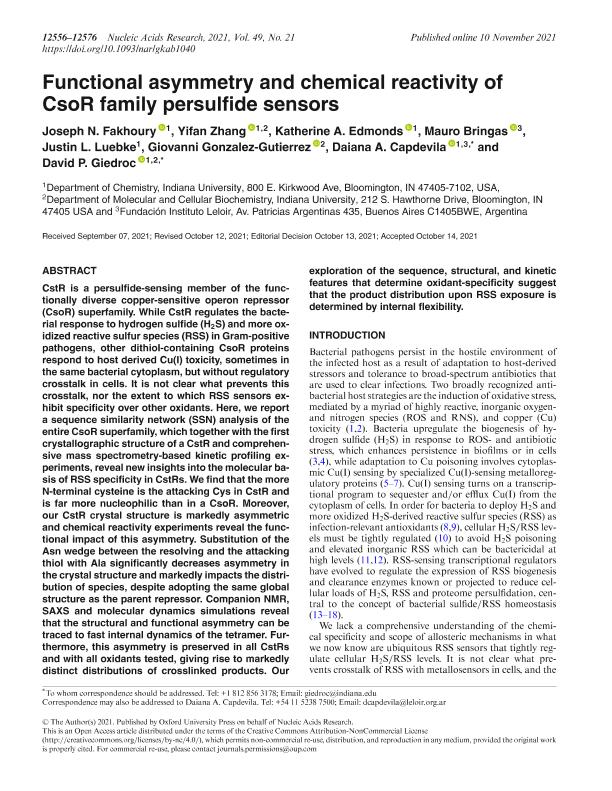Artículo
Functional asymmetry and chemical reactivity of CsoR family persulfide sensors
Fakhoury, Joseph N; Zhang, Yifan; Edmonds, Katherine A; Bringas, Mauro ; Luebke, Justin L; Gonzalez Gutierrez, Giovanni; Capdevila, Daiana Andrea
; Luebke, Justin L; Gonzalez Gutierrez, Giovanni; Capdevila, Daiana Andrea ; Giedroc, David Peter
; Giedroc, David Peter
 ; Luebke, Justin L; Gonzalez Gutierrez, Giovanni; Capdevila, Daiana Andrea
; Luebke, Justin L; Gonzalez Gutierrez, Giovanni; Capdevila, Daiana Andrea ; Giedroc, David Peter
; Giedroc, David Peter
Fecha de publicación:
12/2021
Editorial:
Oxford University Press
Revista:
Nucleic Acids Research
ISSN:
0305-1048
e-ISSN:
1362-4962
Idioma:
Inglés
Tipo de recurso:
Artículo publicado
Clasificación temática:
Resumen
CstR is a persulfide-sensing member of the functionally diverse copper-sensitive operon repressor (CsoR) superfamily. While CstR regulates the bacterial response to hydrogen sulfide (H2S) and more oxidized reactive sulfur species (RSS) in Gram-positive pathogens, other dithiol-containing CsoR proteins respond to host derived Cu(I) toxicity, sometimes in the same bacterial cytoplasm, but without regulatory crosstalk in cells. It is not clear what prevents this crosstalk, nor the extent to which RSS sensors exhibit specificity over other oxidants. Here, we report a sequence similarity network (SSN) analysis of the entire CsoR superfamily, which together with the first crystallographic structure of a CstR and comprehensive mass spectrometry-based kinetic profiling experiments, reveal new insights into the molecular basis of RSS specificity in CstRs. We find that the more N-terminal cysteine is the attacking Cys in CstR and is far more nucleophilic than in a CsoR. Moreover, our CstR crystal structure is markedly asymmetric and chemical reactivity experiments reveal the functional impact of this asymmetry. Substitution of the Asn wedge between the resolving and the attacking thiol with Ala significantly decreases asymmetry in the crystal structure and markedly impacts the distribution of species, despite adopting the same global structure as the parent repressor. Companion NMR, SAXS and molecular dynamics simulations reveal that the structural and functional asymmetry can be traced to fast internal dynamics of the tetramer. Furthermore, this asymmetry is preserved in all CstRs and with all oxidants tested, giving rise to markedly distinct distributions of crosslinked products. Our exploration of the sequence, structural, and kinetic features that determine oxidant-specificity suggest that the product distribution upon RSS exposure is determined by internal flexibility.
Archivos asociados
Licencia
Identificadores
Colecciones
Articulos(IIBBA)
Articulos de INST.DE INVEST.BIOQUIMICAS DE BS.AS(I)
Articulos de INST.DE INVEST.BIOQUIMICAS DE BS.AS(I)
Citación
Fakhoury, Joseph N; Zhang, Yifan; Edmonds, Katherine A; Bringas, Mauro; Luebke, Justin L; et al.; Functional asymmetry and chemical reactivity of CsoR family persulfide sensors; Oxford University Press; Nucleic Acids Research; 49; 21; 12-2021; 12556-12576
Compartir
Altmétricas



